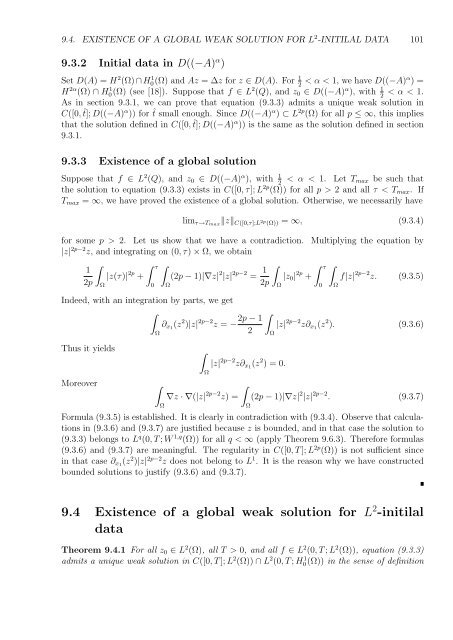Optimal Control of Partial Differential Equations
Optimal Control of Partial Differential Equations
Optimal Control of Partial Differential Equations
Create successful ePaper yourself
Turn your PDF publications into a flip-book with our unique Google optimized e-Paper software.
9.4. EXISTENCE OF A GLOBAL WEAK SOLUTION FOR L 2 -INITILAL DATA 101<br />
9.3.2 Initial data in D((−A) α )<br />
Set D(A) = H2 (Ω) ∩ H1 0(Ω) and Az = ∆z for z ∈ D(A). For 1<br />
2 < α < 1, we have D((−A)α ) =<br />
H2α (Ω) ∩ H1 0(Ω) (see [18]). Suppose that f ∈ L2 (Q), and z0 ∈ D((−A) α ), with 1 < α < 1.<br />
2<br />
As in section 9.3.1, we can prove that equation (9.3.3) admits a unique weak solution in<br />
C([0, ˆt]; D((−A) α )) for ˆt small enough. Since D((−A) α ) ⊂ L2p (Ω) for all p ≤ ∞, this implies<br />
that the solution defined in C([0, ˆt]; D((−A) α )) is the same as the solution defined in section<br />
9.3.1.<br />
9.3.3 Existence <strong>of</strong> a global solution<br />
Suppose that f ∈ L 2 (Q), and z0 ∈ D((−A) α ), with 1<br />
2 < α < 1. Let Tmax be such that<br />
the solution to equation (9.3.3) exists in C([0, τ]; L 2p (Ω)) for all p > 2 and all τ < Tmax. If<br />
Tmax = ∞, we have proved the existence <strong>of</strong> a global solution. Otherwise, we necessarily have<br />
limτ→Tmaxz C([0,τ];L 2p (Ω)) = ∞, (9.3.4)<br />
for some p > 2. Let us show that we have a contradiction. Multiplying the equation by<br />
|z| 2p−2z, and integrating on (0, τ) × Ω, we obtain<br />
<br />
1<br />
2p<br />
|z(τ)| 2p τ <br />
+ (2p − 1)|∇z| 2 |z| 2p−2 = 1<br />
<br />
2p<br />
|z0| 2p τ <br />
+ f|z| 2p−2 z. (9.3.5)<br />
Ω<br />
0<br />
Ω<br />
Indeed, with an integration by parts, we get<br />
<br />
∂x1(z 2 )|z| 2p−2 <br />
2p − 1<br />
z = −<br />
2<br />
Ω<br />
Ω<br />
Ω<br />
0<br />
Ω<br />
|z| 2p−2 z∂x1(z 2 ). (9.3.6)<br />
Thus it yields <br />
|z|<br />
Ω<br />
2p−2 z∂x1(z 2 ) = 0.<br />
Moreover <br />
∇z · ∇(|z|<br />
Ω<br />
2p−2 <br />
z) = (2p − 1)|∇z|<br />
Ω<br />
2 |z| 2p−2 . (9.3.7)<br />
Formula (9.3.5) is established. It is clearly in contradiction with (9.3.4). Observe that calculations<br />
in (9.3.6) and (9.3.7) are justified because z is bounded, and in that case the solution to<br />
(9.3.3) belongs to Lq (0, T ; W 1,q (Ω)) for all q < ∞ (apply Theorem 9.6.3). Therefore formulas<br />
(9.3.6) and (9.3.7) are meaningful. The regularity in C([0, T ]; L2p (Ω)) is not sufficient since<br />
in that case ∂x1(z 2 )|z| 2p−2z does not belong to L1 . It is the reason why we have constructed<br />
bounded solutions to justify (9.3.6) and (9.3.7).<br />
9.4 Existence <strong>of</strong> a global weak solution for L 2 -initilal<br />
data<br />
Theorem 9.4.1 For all z0 ∈ L 2 (Ω), all T > 0, and all f ∈ L 2 (0, T ; L 2 (Ω)), equation (9.3.3)<br />
admits a unique weak solution in C([0, T ]; L 2 (Ω)) ∩ L 2 (0, T ; H 1 0(Ω)) in the sense <strong>of</strong> definition

















